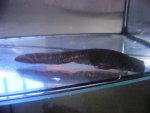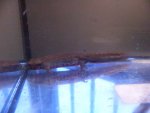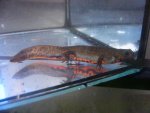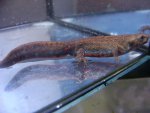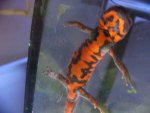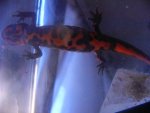A fellow spanish hobbyists was given a pair of Hypselotriton. She didn´t really want a new species as she is only interested in keeping H.orientalis so she offered them to someone else in exchange of CB orientalis. I offered to take them in, fearing that they might have ended somewhere less pleasant, and i will be sending lots of eggs to her in exchange (which is great since i can never raise a lot of juvies anyway).
Apparently they have been handed down through a series of owners, but i ignore how many or where they were originally obtained from. I assume that in all probability they are WC. Nothing indicates the contrary.
They were sent yesterday and arrived today. They look very healthy although obviously stressed. I don´t know if i´ll end up keeping them myself or giving them away to someone else. I really should not increase the number of animals i keep....not a good idea at all...plus, to be honest, as lovely as they are (which they really are!), i´m not interested in Hypselotriton without locality.
Still, i´m trying to figure out what species they are. My best guess is probably H.chenggongensis, but it´s just that...a guess. I´m not even remotely familiar enough with the H.chenggongensis/H.cyanurus/H.yunnanensis group to make a decent identification.
I´m attaching a few pics taken by their previous owner as i haven´t been able to take any myself. I´ll update with more pictures, as well as meassurements, when i´m able to take them.
I realize, without locality data, identifying them may not even be possible, but i would apreciate opinions from those of you who are more familiar with these species.
Thank you.
Apparently they have been handed down through a series of owners, but i ignore how many or where they were originally obtained from. I assume that in all probability they are WC. Nothing indicates the contrary.
They were sent yesterday and arrived today. They look very healthy although obviously stressed. I don´t know if i´ll end up keeping them myself or giving them away to someone else. I really should not increase the number of animals i keep....not a good idea at all...plus, to be honest, as lovely as they are (which they really are!), i´m not interested in Hypselotriton without locality.
Still, i´m trying to figure out what species they are. My best guess is probably H.chenggongensis, but it´s just that...a guess. I´m not even remotely familiar enough with the H.chenggongensis/H.cyanurus/H.yunnanensis group to make a decent identification.
I´m attaching a few pics taken by their previous owner as i haven´t been able to take any myself. I´ll update with more pictures, as well as meassurements, when i´m able to take them.
I realize, without locality data, identifying them may not even be possible, but i would apreciate opinions from those of you who are more familiar with these species.
Thank you.

